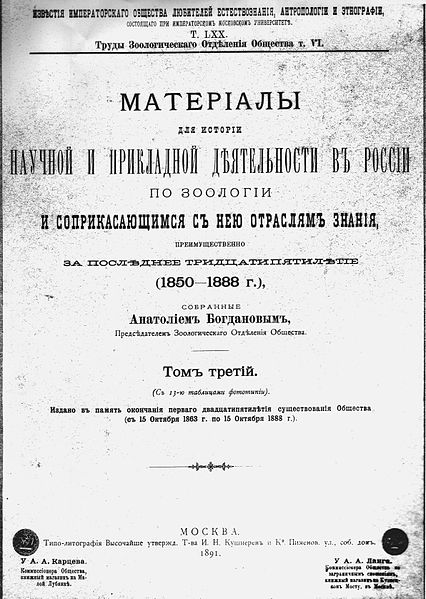Society Of Devotees Of Natural Science, Anthropology, And Ethnography on:
[Wikipedia]
[Google]
[Amazon]
 The Society of Devotees of Natural Science, Anthropology, and Ethnography (OLEAE; russian: Императорское общество любителей естествознания, антропологии и этнографии (ОЛЕАЭ)) was a public scientific organization in the
The Society of Devotees of Natural Science, Anthropology, and Ethnography (OLEAE; russian: Императорское общество любителей естествознания, антропологии и этнографии (ОЛЕАЭ)) was a public scientific organization in the
Presidential Library, Retrieved 17 November 2015
 In 1868
In 1868
 The Society of Devotees of Natural Science, Anthropology, and Ethnography (OLEAE; russian: Императорское общество любителей естествознания, антропологии и этнографии (ОЛЕАЭ)) was a public scientific organization in the
The Society of Devotees of Natural Science, Anthropology, and Ethnography (OLEAE; russian: Императорское общество любителей естествознания, антропологии и этнографии (ОЛЕАЭ)) was a public scientific organization in the Russian Empire
The Russian Empire was an empire and the final period of the Russian monarchy from 1721 to 1917, ruling across large parts of Eurasia. It succeeded the Tsardom of Russia following the Treaty of Nystad, which ended the Great Northern War. ...
and its successor states from 1863 to 1931. Members included scientists and professors but also educated laymen interested in the subjects as an avocation.
The society was involved in the organization of natural science expeditions, exhibitions of finds from these various missions, public science education, and promoting of funding for science in the Russian Empire and later in the USSR
The Soviet Union,. officially the Union of Soviet Socialist Republics. (USSR),. was a transcontinental country that spanned much of Eurasia from 1922 to 1991. A flagship communist state, it was nominally a federal union of fifteen nationa ...
.
History
The society was founded at Moscow University in 1863 under the name "Society of Natural Scientists". A department of anthropology was added in 1864 at the initiative of Anatoli Petrovich Bogdanov, Professor of Zoology and Anthropology at Moscow University, and other departments were added in subsequent years. The society's first President was Gregory Ephimovich Shchurovsky and he together with other leading members of the society discussed having a museum. Their first move in this direction was to establish a library this held books documenting the history of science and technology. This became the central polytechnic library but this established their ambitions. In 1871 Moscow council set aside half a million roubles to create a museum. A committee was formed with Grand Duke Konstantin Nikolayevich as honorary chair. The formation of a museum was timely as Peter the Great's 200th anniversary would inspire an exhibition that would be used to launch the new Polytechnic Museum.The Polytechnical Museum opened in MoscowPresidential Library, Retrieved 17 November 2015
An expedition to Turkestan
 In 1868
In 1868 Alexei Pavlovich Fedchenko
Alexei Pavlovich Fedchenko (russian: Алексей Павлович Федченко;
31 August/15 September 1873), a.k.a. Alexei Pavlovich Fedtschenko, was a Russian naturalist and explorer well known for his travels in central Asia. Alterna ...
was recommended by the society to undertake a hazardous mission to recently conquered region of Russian Turkestan
Russian Turkestan (russian: Русский Туркестан, Russkiy Turkestan) was the western part of Turkestan within the Russian Empire’s Central Asian territories, and was administered as a Krai or Governor-Generalship. It comprised the ...
. His wife Olga Fedchenko was a full, but unpaid, member of the team. The mission was hazardous because Turkestan was still transitioning to becoming part of the Russian Empire. Fedchenko had been recommended to the first Governor-General Konstantin von Kaufman
Konstantin Petrovich von Kaufmann (russian: Константи́н Петро́вич Ка́уфман; 2 March 1818 – 16 May 1882), was the first Governor-General of Russian Turkestan.
Early life
His family was German in origin (from Holste ...
. Kaufman wanted an investigation of what he saw as a "newly and scarcely explored region". Kaufman set up a Tashkent outpost of this society.
The Fenchenkos made three separate explorations between 1868 and 1872. Kaufman was targeting the 1872 Moscow All-Russian Technical Exhibition
The Society of Devotees of Natural Science, Anthropology, and Ethnography (OLEAE; russian: Императорское общество любителей естествознания, антропологии и этнографии (ОЛЕАЭ)) ...
as an opportunity to display their research. Alexei died in 1873 in a climbing accident on Mont Blanc
Mont Blanc (french: Mont Blanc ; it, Monte Bianco , both meaning "white mountain") is the highest mountain in the Alps and Western Europe, rising above sea level. It is the second-most prominent mountain in Europe, after Mount Elbrus, and ...
Olga buried her husband at Chamonix and at the request of the society continued to publish their work.
In 1871 the society changed its name to "Society of Devotees of Natural Science, Anthropology, and Ethnography"
The society published various journals including ''Proceedings of the Society of Natural History, Anthropology and Ethnography'' (1863–1917), ''Ethnographic Review'' (1889–1917), ''Geography'' (1894–1924), and ''Russian Journal of Anthropology'' (1900–1916). The society took the lead in establishing the Polytechnical Museum
The Polytechnic Museum (russian: Политехнический музей) is one of the oldest science museums in the world and is located in Moscow. It showcases Russian and Soviet technology and science, as well as modern inventions. It was fo ...
in Moscow, opened on December 12, 1872. Society members won numerous awards and medals for their work, For its contributions to Russian science the society was permitted to style itself "Imperial Society of Devotees of Natural Science, Anthropology, and Ethnography".
In 1931 the society was merged into the Moscow Society of Natural Scientists.
Presidents of the society
* G. E. Shchurovsky (1863–1884) * August Yulevich Davidov (1884–1885) * Anatoli Petrovich Bogdanov (1886–1889) * Vsevolod Fyodorovich Miller (1889–1890) *Dmitry Nikolayevich Anuchin
Dmitry Nikolayevich Anuchin ( Russian: Дми́трий Никола́евич Ану́чин; 27 August 1843 – 4 June 1923) was a Russian Empire anthropologist, ethnographist, archaeologist, and geographer. He was a member of the Russian Geo ...
(1890–1923)
* Alexei Nikolaevich Severtsov (1923–1931)
References
{{Authority control Scientific organizations established in 1863 Organizations disestablished in 1931 Science and technology in Russia